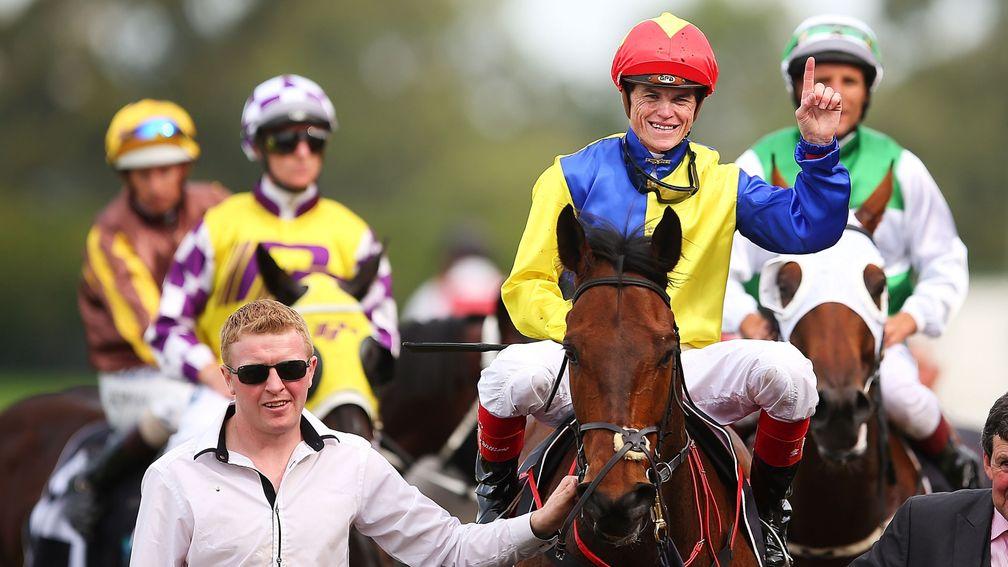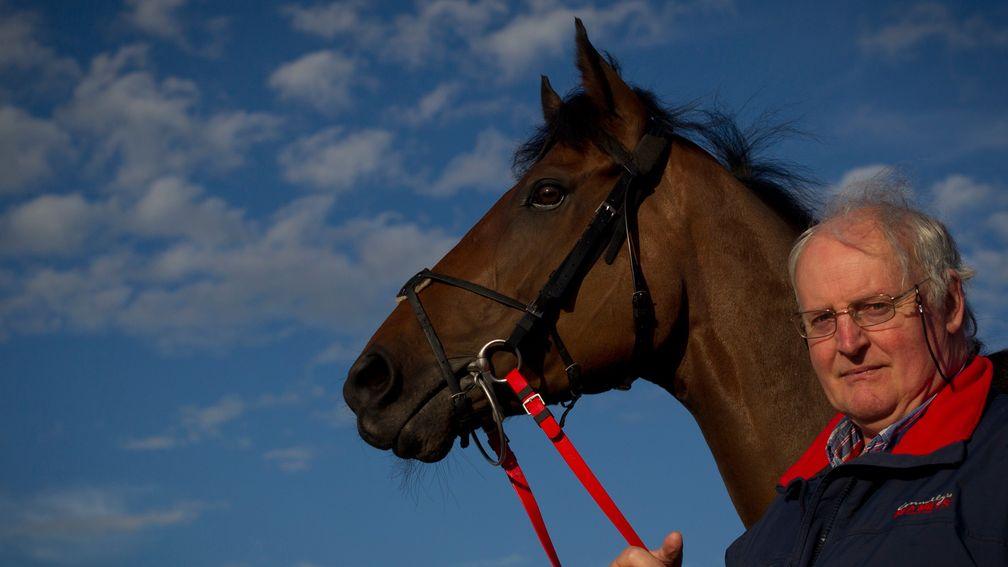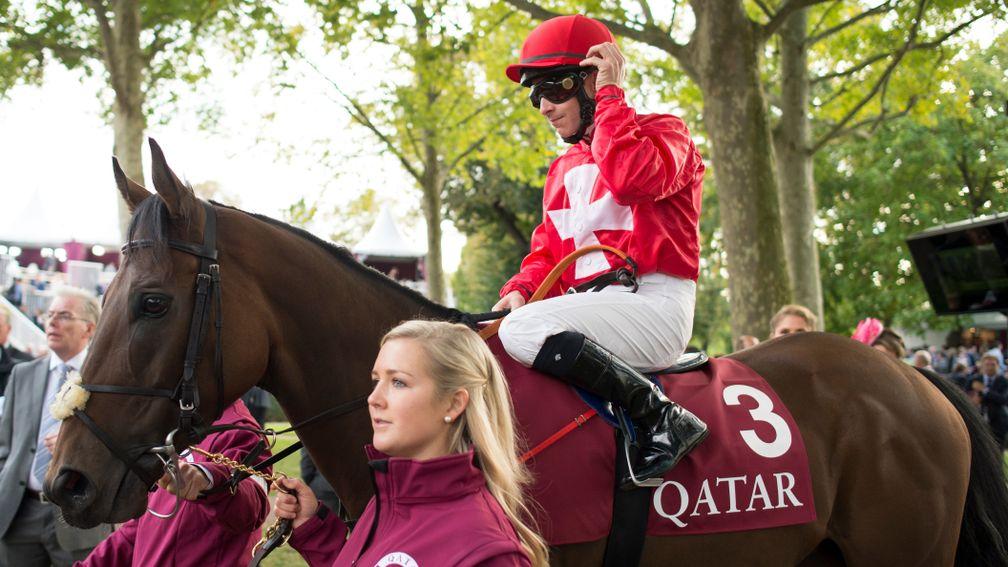How Gordon Lord Byron took on the Aussies in their own backyard and made history
Nick Pulford on the late superstar's historic Group 1 win in Sydney in 2014

This article first appeared in the Racing Post Annual 2015
Take a good look at the picture above. Something extraordinary has just happened, something unique, but you wouldn’t necessarily know it. And that man leading the horse, you wouldn’t realise that just a year before he was told he had little chance of walking again. Now he is taking the proudest walk of his life.
The date is March 29, 2014, the place is Rosehill Gardens racecourse and the horse is Gordon Lord Byron, and what just happened is that he became the first horse from the northern hemisphere to win a Group 1 in Sydney. There had been successful Group 1 raids on Melbourne, but not on Australia’s other great racing centre. In the ever shrinking racing world, Gordon Lord Byron’s connections had found an unconquered corner and planted an Irish flag there. This was a moment of history.
The man at Gordon Lord Byron’s side is Eddie Power, travelling head man for trainer Tom Hogan. He had been there every step of the way, from quarantine in Newmarket before the flight to Australia to another spell in isolation in Melbourne and then finally to Sydney for Group 1 glory on the other side of the world. Yet, in truth, Power’s journey was longer and more remarkable than that, as was Gordon Lord Byron’s, and Hogan’s.
Let’s go back first to May 3, 2013. This time the place is Kilbeggan racecourse and the horse is Ballinahow Oscar, who has just unseated Power at the second flight in a maiden hurdle. Power, just starting his 12th season as a jump jockey, will not be walking away from this one. His race-riding career, highlighted three years earlier by a Grade 2 victory on former Queen Mother Champion Chase winner Newmill, is over.
“I shattered my T5 vertebra and cracked the T7, T6, T4, T3 and dislocated my spine as well,” says Power. “I had to get two rods and 14 screws in my back. It was quite a delicate operation and before the surgery I was given a low percentage of ever walking again. The top part of my back is solid now with all the rods and screws and the bottom part is high-risk. It’s too risky to give me back my licence and for me to ride again.”
Power’s rehabilitation took more than six months but, with determination and a lot of help and support, he got back on his feet. “Getting through it and getting mobile again was the number one aim. I’m quite lucky to be as good as I am. I’m very good, to be honest, you wouldn’t know I’d had any fall.”
Then came the question of what he was going to do with the rest of his life. It is difficult enough when there has been time to plan for a post-riding career, but even more so when the end comes so abruptly and a long period of rehabilitation takes you out of sight and out of mind. “You’re very soon forgotten in this game,” Power says, but fortunately he wasn’t by Hogan.
The two of them go back a long way, to Power’s late teens when he started out as an amateur rider. Hogan gave him his first winner, Premier Rebel at Ballinrobe in 2004, and nine years later the one that turned out to be his last, Coolnagorna Giggs at the same track. Three days later, on his very next ride, came the fateful fall. At that time, Power had been combining race-riding with an assistant/head man role at Hogan’s yard in County Tipperary and, by happy coincidence, he was back on his feet after his long rehabilitation at just the moment Hogan needed a travelling assistant to take Gordon Lord Byron to Hong Kong’s big December meeting.
Not for the first time, Gordon Lord Byron was about to rescue someone from dark despair and send them on an unimaginable journey to the glittering hotspots of the racing world. Hogan knew the feeling, because it had happened to him.
Let's go back in time again, to June 2012, and a knife-edge decision that every trainer dreads. Hogan had almost been dragged under by the recession and nearly lost Gordon Lord Byron, the one horse who might save him, to a pelvic injury. Now, having nursed him back, he faced the possibility that owner Morgan Cahalan would sell the then four-year-old just when he was ready to break through into top handicap and black-type races. Cahalan could have done with the money – close to €200,000 – but in the end he reasoned that he would never have the opportunity to own another like Gordon Lord Byron.
No wonder Hogan did not hesitate when asked in the summer of 2014 if this was a career-saving horse. “Oh yeah,” he said. “If I didn’t have Gordon I wouldn’t still be in the game, I wouldn’t still be going.”

More brave decisions followed, and many of them were rewarded, as Gordon Lord Byron travelled around winning fans and big prizes. In his last four races of 2012, he won a Listed race at York, finished second in the Haydock Sprint Cup, won the Prix de la Foret on Arc day at Longchamp and finished fourth in the Hong Kong Mile at Sha Tin. Hogan had won that €200,000, and more, for Cahalan.
As he was a gelding who loved travelling, there was no reason to stop with Gordon Lord Byron. In 2013 he made the first four in Group 1 races in four different countries, the highlight being his Haydock Sprint Cup triumph over Slade Power, and ended up in Hong Kong with Power alongside him. Then came the invitation from Racing New South Wales, principally for The Championships at Randwick in early April that had been created to encourage international competition. The connections of Gordon Lord Byron, globetrotter par excellence, were hardly likely to turn down that opportunity.
So here they all were, together in Sydney: the horse who was once a cripple, the former jockey who might never have walked again, the trainer who had been on the brink of going under and the owner who had almost sold the horse of a lifetime. United in a quest for a slice of racing history.
Things did not start well. Hogan had been promised a work horse while Gordon Lord Byron was in quarantine in Melbourne but that horse bled on the first morning they went out. “It was a little bit tricky,” recalls Hogan, with masterly understatement. “But full marks to my team out there, they did a great job.”
The team was Power and work rider Kate O’Brien, for whom this was a last great adventure with her beloved Gordon Lord Byron before she headed off to London to study physiotherapy. O’Brien knew the horse inside out and Power, having been involved with the Hogan yard for so long, knew the training programme to follow.
“At this stage I’m like one of his sons,” he says. “I know exactly how Tom likes everything done and how he trains the horses, so I carry on Tom’s routine and make sure it’s done to his standards. Kate was riding, she knows him better than I do. She’s in love with him. When we got to Sydney they gave us a second work horse and he was a lot better.”
The TJ Smith Stakes at Randwick was the main aim, but first there was a Group 1 opportunity in the George Ryder Stakes at Rosehill, out in Sydney’s western suburbs. Gordon Lord Byron had been out of quarantine for only ten days and this was viewed as more of a prep race but conditions were right for him: seven and a half furlongs, a right-handed track and ground with just a bit of cut. “They called it soft,” Hogan says, “but in Ireland we would say it was good to yielding, where they just put a print in the ground.” All in all, conditions were similar to the day he had won the Prix de la Foret at Longchamp.
Gordon Lord Byron’s performance was similar too. He travelled well in midfield under Australian jockey Craig Williams, was ridden well over a furlong out to chase the leaders, ran on strongly in the final furlong and got up in the final strides. He won by a short neck – a remarkable performance so soon after arriving.
For Power, leading in the horse, it was an unforgettable moment. “Everything clicked that day,” he says. “One day like that makes it all worthwhile for 100 hard days. What he did was exceptional.”
Gordon Lord Byron was the first northern-hemisphere horse to win at the top level in Sydney and, while it may not rank as highly as Dermot Weld’s Melbourne Cups with Vintage Crop and Media Puzzle, the many British and Irish raiders who have failed in that race put into perspective the difficulty of winning on the other side of the globe.
“After the George Ryder, Chris Waller – he’s the champion trainer there at the moment – asked me if I realised what I’d just done,” Hogan recalled. “He said they bring out horses from Europe and they can’t get them to show form for months and they were amazed that I could do it straight out of quarantine.”
Power was surprised there was not the same reaction in Ireland. “We got a great reception in Australia, especially from the Irish community,” he says. “He had a good following in Australia but not back home. I was expecting to come back and find people thought something amazing had happened but I don’t think people realised what he had accomplished.”
That could not take the gloss off the trip for Power, nor the fact that Gordon Lord Byron was well beaten in the TJ Smith at Randwick a fortnight later. This time the ground was heavy, properly gluey, and that scuppered his chance. “When the ground becomes heavy in Australia, it becomes unstable, and he hated it,” Hogan says. “He just couldn’t get traction on it. He’s a good-actioned horse who has had pelvic problems and he needs to get traction.”

For a while, after returning home, it seemed the rigours of the journey had taken their toll but the moral of Gordon Lord Byron’s tale is never to write him off. In the autumn of 2014 he bounced back to form with second places in the Haydock Sprint Cup and Prix de la Foret, giving him the proud record of having finished in the first four in 11 of his 16 Group 1 starts up to that point. His next run was in a Group 2, the British Champions Sprint at Ascot, and this time he won, for the first time since Rosehill.
It was a fitting finale to another incredible year for Gordon Lord Byron and his connections. His is an uplifting story of triumphing against the odds, of coming back from the brink, and the people around him have their own remarkable tales to tell. On March 29, 2014 they all wrote a unique chapter together and the story is far from over.
If you enjoyed this, you might like:
'I've worked out it's cost me £56,000 to date' - Sir Mark Prescott on Covid-19
Frankie Dettori: 'All I wanted to do was finish my day, get in the shower and punch the wall'
Lester Piggott: 'It's nice to be popular. It's better than having stones thrown at me, anyway'
The Racing Post newspaper is back in shops! With extensive coverage of all the racing, interviews with the biggest names, tipping from our renowned experts and all the cards and form, it's your unmissable guide to all the action. Don't forget to pick up your copy today
Published on 9 June 2020inNews
Last updated 15:18, 9 June 2020
- The latest edition of the Racing Post is available to read online now - here's how you can access it
- How Smart View recorded a 76 per cent profit at the Cheltenham Festival
- Smart View is available on the Racing Post app - how to read the revolutionary new racecard
- Levy reform talks 'accelerating' as clock ticks down to April deadline for agreement
- Kieran Shoemark lands another plum Meydan ride for Gosden stable on Trawlerman in Saturday's Dubai Gold Cup
- The latest edition of the Racing Post is available to read online now - here's how you can access it
- How Smart View recorded a 76 per cent profit at the Cheltenham Festival
- Smart View is available on the Racing Post app - how to read the revolutionary new racecard
- Levy reform talks 'accelerating' as clock ticks down to April deadline for agreement
- Kieran Shoemark lands another plum Meydan ride for Gosden stable on Trawlerman in Saturday's Dubai Gold Cup